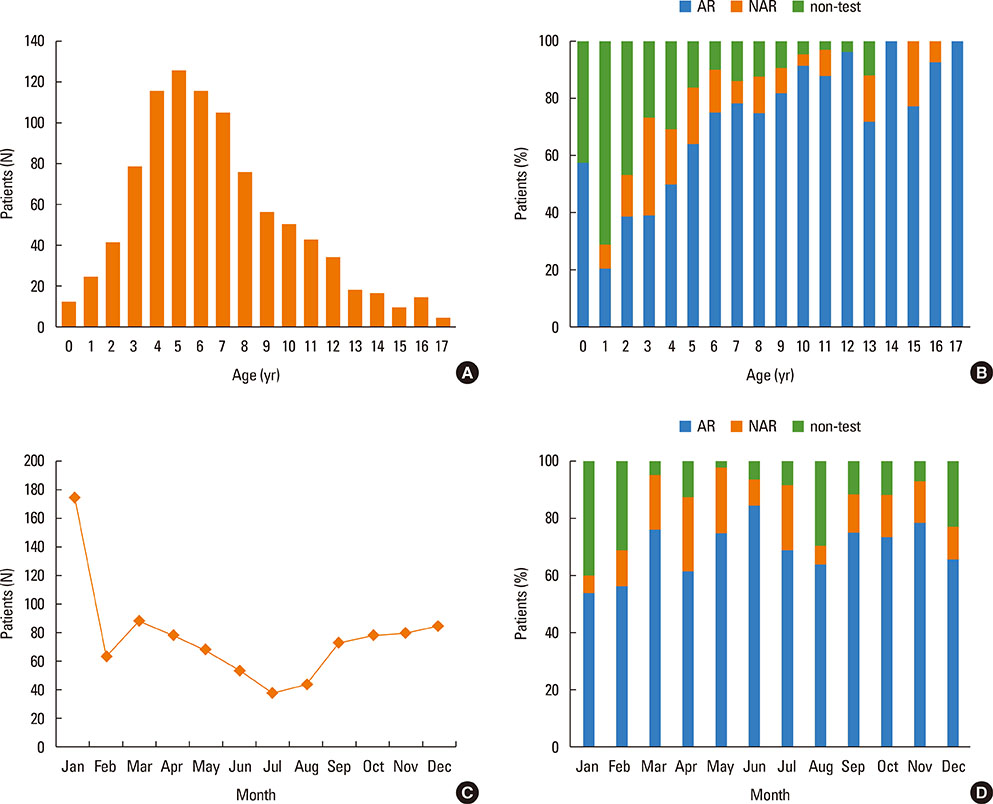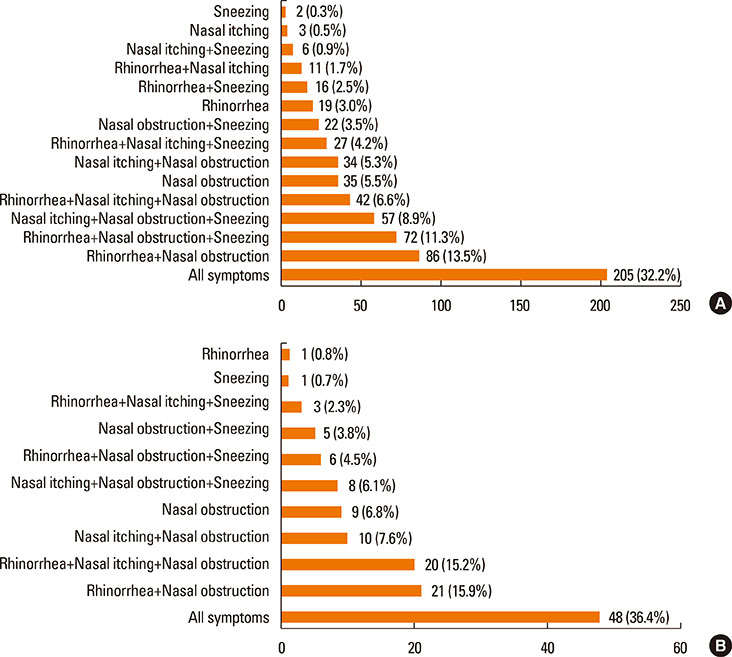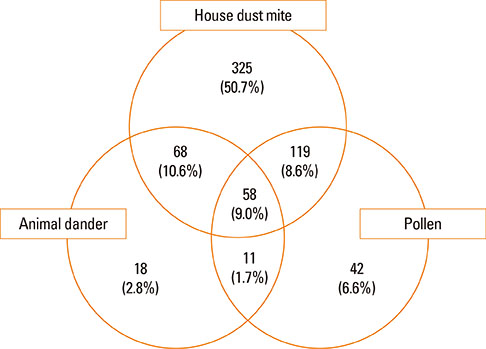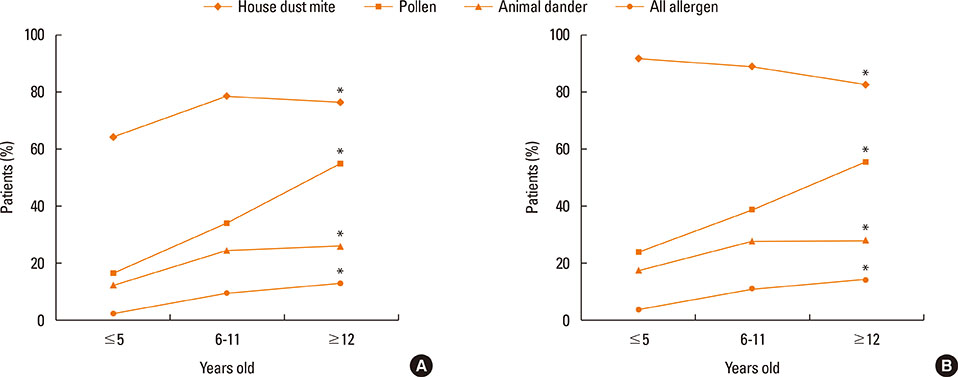Allergy Asthma Immunol Res.
2017 Jan;9(1):70-78. 10.4168/aair.2017.9.1.70.
Comorbidities and Phenotypes of Rhinitis in Korean Children and Adolescents: A Cross-sectional, Multicenter Study
- Affiliations
-
- 1Department of Pediatrics, CHA Bundang Medical Center, CHA University School of Medicine, Seongnam, Korea.
- 2Department of Pediatrics, Seoul Medical Center, Seoul, Korea.
- 3Department of Pediatrics, CHA Gangnam Medical Center, CHA University School of Medicine, Seoul, Korea.
- 4Department of Pediatrics, Konkuk University Medical Center, Konkuk University School of Medicine, Seoul, Korea.
- 5Department of Pediatrics, Hallym University Kangnam Sacred Heart Hospital, Seoul, Korea.
- 6Department of Pediatrics, Kyungpook National University School of Medicine, Daegu, Korea.
- 7Department of Pediatrics, Kyung Hee University Hospital at Gangdong, Kyung Hee University School of Medicine, Seoul, Korea.
- 8Department of Pediatrics, The Catholic University of Korea College of Medicine, Seoul, Korea.
- 9Department of Pediatrics, Wonkwang University Sanbon Hospital, Wonkwang University College of Medicine, Gunpo, Korea.
- 10Department of Pediatrics, Inje University Sanggye Paik Hospital, Seoul, Korea.
- 11Department of Pediatrics, Kyung Hee University Hospital, Kyung Hee University School of Medicine, Seoul, Korea. yhrha@khu.ac.kr
- KMID: 2355896
- DOI: http://doi.org/10.4168/aair.2017.9.1.70
Abstract
- PURPOSE
Rhinitis is a nasal inflammatory disease in children and adolescents. However, little is known about the phenotypes and characteristics of allergic rhinitis (AR) in Korean children and adolescents. The objective of this study was to analyze the symptoms and comorbidities of rhinitis, to compare AR to non-allergic rhinitis (NAR), and to reveal the phenotypes and features of AR in a Korean pediatric population.
METHODS
Patients under 18 years of age with rhinitis symptoms were recruited from January 2013 to January 2015 by pediatric allergists. We analyzed symptoms, phenotypes, comorbidities, and allergen sensitization in this cross-sectional, multicenter study.
RESULTS
Medical records were collected from 11 hospitals. The AR group has 641 (68.3%) patients, with 63.2% of boys and 7.5 (±3.4) years of mean age. The NAR group has 136 (14.5%) patients, with 55.1% of boys and 5.5 (±2.9) years of mean age. Moderate-severe persistent AR affected 41.2% of AR patients. Nasal obstruction was more common in NAR patients (P<0.050), whereas AR patients sneezed more (P<0.050) and more commonly had conjunctivitis, asthma, and otitis media (P<0.050). Sinusitis was the most common comorbidity in both groups. Allergen sensitization was caused by house dust mites (HDMs) (90.2%), pollen (38.7%), and animal dander (24.8%) in AR patients. Pollen and animal dander sensitization significantly increased age-dependently (P<0.050), but 91.9% of AR patients were already sensitized to HDMs before 5 years old.
CONCLUSIONS
Our study revealed that AR was more prevalent than NAR and that 41.2% of AR presented with moderate-severe disease in Korean pediatric populations. Sinusitis was the most common comorbidity, and sleep disturbance was associated with the severity of rhinitis. The majority of AR patients were sensitized to HDMs in preschool ages. Further studies, including nationwide and longitudinal data, will help understand the relationship between these diseases.
Keyword
MeSH Terms
Figure
Cited by 2 articles
-
Research on pediatric allergic rhinitis in Korea
Kyung Suk Lee, Yeong Ho Rha
Allergy Asthma Respir Dis. 2018;6(Suppl 1):S58-S65. doi: 10.4168/aard.2018.6.S1.S58.A Retrospective Study of Clinical Response Predictors in Subcutaneous Allergen Immunotherapy With House Dust Mites for Allergic Rhinitis
Ji-Ho Lee, Su-Chin Kim, Hyunna Choi, Chang-Gyu Jung, Ga-Young Ban, Yoo Seob Shin, Dong-Ho Nahm, Hae-Sim Park, Young-Min Ye
Allergy Asthma Immunol Res. 2018;10(1):18-24. doi: 10.4168/aair.2018.10.1.18.
Reference
-
1. Seo JH, Kim HY, Jung YH, Lee E, Yang SI, Yu HS, et al. Interactions between innate immunity genes and early-life risk factors in allergic rhinitis. Allergy Asthma Immunol Res. 2015; 7:241–248.2. Bousquet J, Khaltaev N, Cruz AA, Denburg J, Fokkens WJ, Togias A, et al. Allergic Rhinitis and its Impact on Asthma (ARIA) 2008 update (in collaboration with the World Health Organization, GA(2)LEN and AllerGen). Allergy. 2008; 63:Suppl 86. 8–160.3. Roberts G, Xatzipsalti M, Borrego LM, Custovic A, Halken S, Hellings PW, et al. Paediatric rhinitis: position paper of the European Academy of Allergy and Clinical Immunology. Allergy. 2013; 68:1102–1116.4. Hong SJ, Ahn KM, Lee SY, Kim KE. The prevalences of asthma and allergic diseases in Korean children. Korean J Pediatr. 2008; 51:343–350.5. Jee HM, Kim KW, Kim CS, Sohn MH, Shin DC, Kim KE. Prevalence of asthma, rhinitis and eczema in Korean children using the International Study of Asthma and Allergies in Childhood (ISAAC) Questionnaires. Pediatr Allergy Respir Dis. 2009; 19:165–172.6. Hong S, Son DK, Lim WR, Kim SH, Kim H, Yum HY, et al. The prevalence of atopic dermatitis, asthma, and allergic rhinitis and the comorbidity of allergic diseases in children. Environ Health Toxicol. 2012; 27:e2012006.7. Bertelsen RJ, Carlsen KC, Carlsen KH. Rhinitis in children: co-morbidities and phenotypes. Pediatr Allergy Immunol. 2010; 21:612–622.8. Silva CH, Silva TE, Morales NM, Fernandes KP, Pinto RM. Quality of life in children and adolescents with allergic rhinitis. Braz J Otorhinolaryngol. 2009; 75:642–649.9. Roberts G, Hurley C, Lack G. Development of a quality-of-life assessment for the allergic child or teenager with multisystem allergic disease. J Allergy Clin Immunol. 2003; 111:491–497.10. Walker S, Khan-Wasti S, Fletcher M, Cullinan P, Harris J, Sheikh A. Seasonal allergic rhinitis is associated with a detrimental effect on examination performance in United Kingdom teenagers: case-control study. J Allergy Clin Immunol. 2007; 120:381–387.11. Kim HY, Kwon EB, Baek JH, Shin YH, Yum HY, Jee HM, et al. Prevalence and comorbidity of allergic diseases in preschool children. Korean J Pediatr. 2013; 56:338–342.12. Kim KH. Overview of atopic dermatitis. Asia Pac Allergy. 2013; 3:79–87.13. Hanifin JM, Rajka G. Diagnostic features of atopic dermatitis. Acta Derm Venereol. 1980; 60:Suppl 92. 44–47.14. Spector SL. Overview of comorbid associations of allergic rhinitis. J Allergy Clin Immunol. 1997; 99:S773–S780.15. Webber CM, England RW. Oral allergy syndrome: a clinical, diagnostic, and therapeutic challenge. Ann Allergy Asthma Immunol. 2010; 104:101–108.16. Hamilton RG. Clinical laboratory assessment of immediate-type hypersensitivity. J Allergy Clin Immunol. 2010; 125:S284–S296.17. Dondi A, Tripodi S, Panetta V, Asero R, Businco AD, Bianchi A, et al. Pollen-induced allergic rhinitis in 1360 Italian children: comorbidities and determinants of severity. Pediatr Allergy Immunol. 2013; 24:742–751.18. Kwon SE, Lim DH, Kim JH, Son BK, Park YS, Jang HJ, et al. Prevalence and allergens of allergic rhinitis in children and adolescents in Gwangju. Allergy Asthma Respir Dis. 2015; 3:54–61.19. Peters RL, Allen KJ, Dharmage SC, Tang ML, Koplin JJ, Ponsonby AL, et al. Skin prick test responses and allergen-specific IgE levels as predictors of peanut, egg, and sesame allergy in infants. J Allergy Clin Immunol. 2013; 132:874–880.20. Wolthers OD, Staberg M. The usefulness of the multiple allergen simultaneous test-chemiluminescent as compared to the Phadia Immunocap IgE test panel system in children and adolescents. Recent Pat Inflamm Allergy Drug Discov. 2013; 7:96–99.21. Kim JS, Kang HS, Jang HJ, Kim JH, Lim DH, Son BK. Clinical features of allergic rhinitis in Korean children. Allergy Asthma Respir Dis. 2015; 3:116–123.22. Westman M, Stjärne P, Asarnoj A, Kull I, van Hage M, Wickman M, et al. Natural course and comorbidities of allergic and nonallergic rhinitis in children. J Allergy Clin Immunol. 2012; 129:403–408.23. Rhee CS, Wee JH, Ahn JC, Lee WH, Tan KL, Ahn S, et al. Prevalence, risk factors and comorbidities of allergic rhinitis in South Korea: the Fifth Korea National Health and Nutrition Examination Survey. Am J Rhinol Allergy. 2014; 28:e107–e114.24. Ibáñez MD, Valero AL, Montoro J, Jauregui I, Ferrer M, Dávila I, et al. Analysis of comorbidities and therapeutic approach for allergic rhinitis in a pediatric population in Spain. Pediatr Allergy Immunol. 2013; 24:678–684.25. Bonay M, Neukirch C, Grandsaigne M, Leçon-Malas V, Ravaud P, Dehoux M, et al. Changes in airway inflammation following nasal allergic challenge in patients with seasonal rhinitis. Allergy. 2006; 61:111–118.26. Bachert C, Vignola AM, Gevaert P, Leynaert B, Van Cauwenberge P, Bousquet J. Allergic rhinitis, rhinosinusitis, and asthma: one airway disease. Immunol Allergy Clin North Am. 2004; 24:19–43.27. Hadley JA, Derebery MJ, Marple BF. Comorbidities and allergic rhinitis: not just a runny nose. J Fam Pract. 2012; 61:S11–S15.28. Skoner DP, Doyle WJ, Fireman P. Eustachian tube obstruction (ETO) after histamine nasal provocation--a double-blind dose-response study. J Allergy Clin Immunol. 1987; 79:27–31.29. Meltzer EO, Blaiss MS, Derebery MJ, Mahr TA, Gordon BR, Sheth KK, et al. Burden of allergic rhinitis: results from the Pediatric Allergies in America survey. J Allergy Clin Immunol. 2009; 124:S43–S70.30. Craig TJ, Sherkat A, Safaee S. Congestion and sleep impairment in allergic rhinitis. Curr Allergy Asthma Rep. 2010; 10:113–121.31. Kim JH, Ahn YM, Kim HJ, Lim DH, Son BK, Kang HS, et al. Development of a questionnaire for the assessment of quality of life in Korean children with allergic rhinitis. Allergy Asthma Immunol Res. 2014; 6:541–547.32. Jin JY, Yang HJ, Jeon YH, Kim KW, Kim WK, Park YM, et al. Development and validation of the questionnaire for quality-of-life specific to allergic rhinitis in Korean children (QQOL-ARK): a multicenter study. Korean J Asthma Allergy Clin Immunol. 2009; 29:242–248.33. Muliol J, Maurer M, Bousquet J. Sleep and allergic rhinitis. J Investig Allergol Clin Immunol. 2008; 18:415–419.34. Qidwai JC, Watson GS, Weiler JM. Sedation, cognition, and antihistamines. Curr Allergy Asthma Rep. 2002; 2:216–222.35. Craig TJ, McCann JL, Gurevich F, Davies MJ. The correlation between allergic rhinitis and sleep disturbance. J Allergy Clin Immunol. 2004; 114:S139–S145.36. Craig TJ, Hanks CD, Fisher LH. How do topical nasal corticosteroids improve sleep and daytime somnolence in allergic rhinitis? J Allergy Clin Immunol. 2005; 116:1264–1266.37. Bousquet J, Annesi-Maesano I, Carat F, Léger D, Rugina M, Pribil C, et al. Characteristics of intermittent and persistent allergic rhinitis: DREAMS study group. Clin Exp Allergy. 2005; 35:728–732.38. Warm K, Hedman L, Lindberg A, Lötvall J, Lundback B, Ronmark E. Allergic sensitization is age-dependently associated with rhinitis, but less so with asthma. J Allergy Clin Immunol. 2015; 136:1559–1565.e1-2.39. Weiland SK, von Mutius E, Hirsch T, Duhme H, Fritzsch C, Werner B, et al. Prevalence of respiratory and atopic disorders among children in the East and West of Germany five years after unification. Eur Respir J. 1999; 14:862–870.40. Salo PM, Arbes SJ Jr, Jaramillo R, Calatroni A, Weir CH, Sever ML, et al. Prevalence of allergic sensitization in the United States: results from the National Health and Nutrition Examination Survey (NHANES) 2005-2006. J Allergy Clin Immunol. 2014; 134:350–359.
- Full Text Links
- Actions
-
Cited
- CITED
-
- Close
- Share
- Similar articles
-
- Prevalence and comorbidity of allergic diseases in preschool children
- The Burden of Rhinitis and Rhinoconjunctivitis in Adolescents
- Prevalence, comorbidities, diagnosis, and treatment of nonallergic rhinitis: real-world comparison with allergic rhinitis
- Endocrine comorbidities of pediatric obesity
- The Prevalence of Atopic Dermatitis, Asthma, and Allergic Rhinitis and the Comorbidity of Allergic Diseases in Children





